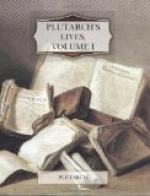XXXII. These words are said to have caused such remorse and repentance among the soldiers, that all the tribes voted Aemilius his triumph. It is said to have been celebrated thus. The people, dressed in white robes, looked on from platforms erected in the horse course, which they call the Circus, and round the Forum, and in all other places which gave them a view of the procession. Every temple was open, and full of flowers and incense, and many officials with staves drove off people who formed disorderly mobs, and kept the way clear. The procession was divided into three days. The first scarcely sufficed for the display of the captured statues, sculptures, and paintings, which were carried on two hundred and fifty carriages. On the following day the finest and most costly of the Macedonian arms and armour were borne along in many waggons, glittering with newly burnished brass and iron, and arranged in a carefully studied disorder, helmets upon shields, and corslets upon greaves, with Cretan targets, Thracian wicker shields and quivers mixed with horses’ bits, naked swords rising out of these, and the long spears of the phalanx ranged in order above them, making a harmonious clash of arms, as they were arranged to clatter when they were driven along, with a harsh and menacing sound, so that the sight of them even after victory was not without terror. After the waggons which bore the arms walked three thousand men, carrying the silver coin in seven hundred and fifty earthen vessels, each carrying three talents, and borne by four men. Others carried the silver drinking horns, and goblets and chalices, each of them disposed so that it could be well seen, and all remarkable for their size and the boldness of their carving.
XXXIII. On the third day, at earliest dawn, marched the trumpeters, not playing the music of a march, but sounding the notes which animate the Romans for a charge. After them were led along a hundred and twenty fat oxen with gilded horns, adorned with crowns and wreaths. They were led by youths clad in finely-fringed waistcloths in which to do the sacrifice, while boys carried the wine for the libations in gold and silver vessels. After these came men carrying the gold coin, divided into vessels of three talents each like the silver. The number of these vessels was eighty all but three. Then came those who carried the consecrated bowl which Aemilius had made of ten talents of gold adorned with jewels, and men carrying the plate of Antigonus and Seleukus, and cups of Therikles-ware,[A] and all Perseus’s own service of gold plate.
[Footnote A: This was a particular kind of pottery, originally made at Corinth.]
Next came the chariot of Perseus with his armour; and his crown set upon the top of his armour: and then after a little interval came the captive children of the king, and with them a tearful band of nurses and teachers, who held out their hands in supplication to the spectators, and taught the children to beg them for mercy. There were two boys and one girl, all too young to comprehend the extent of their misfortune. This carelessness made their fallen state all the more pitiable, so that Perseus himself walked almost unnoticed; for the Romans in their pity had eyes only for the children, and many shed tears, while all felt that the sight was more painful than pleasing till the children were gone by.




